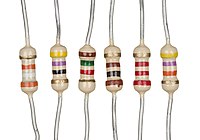
Photo from wikipedia
The substrate boards of commercial roofs are secured with mechanical fasteners and plates. The pull-through resistance (PTR) of the substrates depends on the material composition and fastener/plate configuration. Three different… Click to show full abstract
The substrate boards of commercial roofs are secured with mechanical fasteners and plates. The pull-through resistance (PTR) of the substrates depends on the material composition and fastener/plate configuration. Three different testing apparatuses are available for determining the PTR: universal testing machine Instron pull-through (IP), automated pull-through (AP), and manual pull-through (MP). To quantify the accuracy of these three test apparatuses, the National Research Council Canada completed an experimental program. The test matrix consisted of four types of substrate boards: gypsum-based board (GB), perlite-based board (PB), wood-fiber based board (WB), and polyisocyanurate insulation based (IB), two fastener plate geometries (round and hexagonal), and two types of fasteners (#12 and #14). In addition, the effect of operator ability and loading mechanisms were respectively examined for the MP and IP by employing three different operators and two different loading mechanisms, respectively. Experimental error, deviation error, and total deviation values are calculated. The findings are, respectively summarized as follows: (1) Data obtained using IP and AP showed no significant difference in the PTR values. However, the MP results varied with operators. (2) Similarly, neither the size of the specimen, the type of fasteners, nor the fastener plates resulted in significant variation in the PTR values obtained from the three apparatuses. (3) Failure analysis of the substrate boards confirmed that larger specimens absorbed energy elastically by deflecting across the board's longer span whereas smaller specimens dissipated energy by cracking across the board.
Journal Title: Journal of Testing and Evaluation
Year Published: 2021
Link to full text (if available)
Share on Social Media: Sign Up to like & get
recommendations!